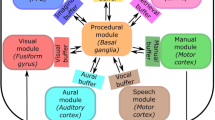Abstract
The Psi theory of human action regulation is a candidate for a cognitive architecture that tackles the problem of the interrelation of motivation and emotion with cognitive processes. We have transferred this theory into a cognitive modeling framework, implemented as an AI architecture, called MicroPsi. Here, we describe the main assumptions of the Psi theory and summarize a neural prototyping algorithm that matches perceptual input to hierarchical declarative representations.
Preview
Unable to display preview. Download preview PDF.
Similar content being viewed by others
References
Detje, F.: Handeln erklären. DUV, Wiesbaden (1999)
Clark, A., Grush, R.: Towards a Cognitive Robotics. Adaptive Behavior 7(1), 5–16 (1999)
Dörner, D.: Eine Systemtheorie der Motivation. Memorandum Lst. Psychologie II Universität Bamberg, 2,9 (1994)
Dörner, D.: Bauplan für eine Seele. Rowohlt, Reinbeck (1999)
Dörner, D., et al.: Die Mechanik des Seelenwagens. Eine neuronale Theorie der Handlungsregulation. Hans Huber, Bern (2002)
Dörner, D.: Die kognitive Organisation beim Problemlösen. Versuche zu einer kybernetischen Theorie der elementaren Informations-verarbeitungsprozesse beim Denken. Kohlhammer, Bern (1974)
Barsalou, L.W.: Perceptual Symbol Systems. Behavioral and Brain Sciences 22(4), 577–660 (1999)
Anderson, J.R., Lebiere, C.: The atomic components of thought. Erlbaum, Mahwah (1998)
Laird, J.E., Newell, A., Rosenbloom, P.J.: Soar: An architecture for general intelligence. Artificial Intelligence 33(1), 1–64 (1987)
Sun, R.: Cognition and Multi-Agent Interaction, pp. 79–103. Cambridge University Press, Cambridge (2005)
Detje, F.: Comparison of the PSI-theory with human behaviour in a complex task. In: Taatgen, N., Aasman, J. (eds.) Proceedings of the Third International Conference on Cognitive Modelling, pp. 86–93. Universal Press, Veenendaal (2000)
Dörner, D.: The Mathematics of Emotion. In: Proceedings of ICCM-5, International Conference on Cognitive Modeling, Bamberg, Germany (2003)
Ritter, F.E., et al.: Techniques for Modeling Human Performance in Synthetic Environments: A Supplementary Review. Human Systems Information Analysis Center, State of the Art Report (2003)
Piaget, J.: The construction of reality in the child. Basic Books, New York (1954)
Towell, G.G., Shavlik, J.W.: Knowledge-based artificial neural networks. Artificial Intelligence 70(1-2), 119–165 (1994)
Sebastian, T.B., Klein, P.N., Kimia, B.B.: Recognition of shapes by editing shockgraphs. In: IEEE International Conference on Computer Vision, pp. 755–762 (2001)
Pelillo, M., Siddiqi, K., Zucker, S.W.: Matching hierarchical structures using association graphs. IEEE Transaction on Pattern Analysis and Machine Intelligence 21, 1105–1120 (1999)
Schädler, K., Wysotzki, F.: Comparing structures using a hopfield-style neural network. Applied Intelligence 11, 15–30 (1999)
Schädler, K., Wysotzki, F.: A connectionist approach to structural similarity determination as a basis of clustering, classification and feature detection. In: Komorowski, J., Żytkow, J.M. (eds.) PKDD 1997. LNCS, vol. 1263, pp. 254–264. Springer, Heidelberg (1997)
Siddiqi, K., et al.: Shock graphs and shape matching. IEEE International Journal on Computer Vision, 222–229 (1998)
Macrini, D.: Indexing and matching for view-based 3-d object recognition using shock graphs. Master’s thesis, University of Toronto (2003)
Shokoufandeh, A., Dickinson, S.J.: A Unified Framework for Indexing and Matching Hierarchical Shape Structures. In: Arcelli, C., Cordella, L.P., Sanniti di Baja, G. (eds.) IWVF 2001. LNCS, vol. 2059, pp. 28–46. Springer, Heidelberg (2001)
Author information
Authors and Affiliations
Editor information
Rights and permissions
Copyright information
© 2007 Springer-Verlag Berlin Heidelberg
About this paper
Cite this paper
Bach, J., Bauer, C., Vuine, R. (2007). MicroPsi: Contributions to a Broad Architecture of Cognition. In: Freksa, C., Kohlhase, M., Schill, K. (eds) KI 2006: Advances in Artificial Intelligence. KI 2006. Lecture Notes in Computer Science(), vol 4314. Springer, Berlin, Heidelberg. https://doi.org/10.1007/978-3-540-69912-5_2
Download citation
DOI: https://doi.org/10.1007/978-3-540-69912-5_2
Publisher Name: Springer, Berlin, Heidelberg
Print ISBN: 978-3-540-69911-8
Online ISBN: 978-3-540-69912-5
eBook Packages: Computer ScienceComputer Science (R0)




